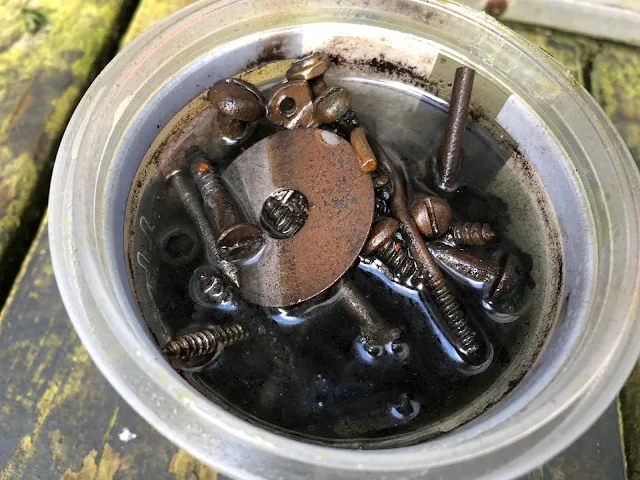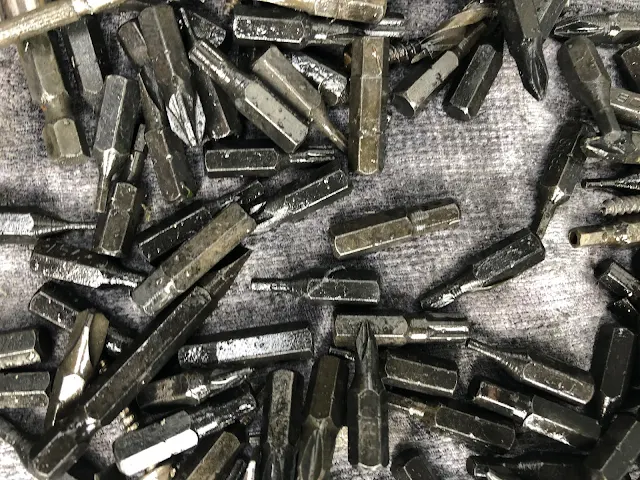🧪My Experiment with Hydrochloric Acid and Rust
Like the musician Neil Young famously sang, rust never sleeps. It's a common problem for anyone with tools; you leave them in a damp spot, and before you know it, an unwelcome layer of rust has appeared on your favorite drill bits, Allen keys, and screwdrivers.
I recently decided to tackle this problem head-on.
While tidying my shed, I found a large jar filled with rusting tools and an old bottle of hydrochloric acid (often sold as muriatic acid).
It seemed like a perfect opportunity for a little home science experiment to see if acid could really remove rust effectively.
🔬What's Happening in the Jar? The Science of Acid vs. Rust
My process was simple. I placed the rusty items in a plastic container, put on my safety glasses, and created a 50:50 solution of hydrochloric acid and water.
As soon as the acid hit the tools, small bubbles started fizzing to the surface, showing that a chemical reaction was happening right away.
Here’s a deeper look at the science behind those bubbles:
- Reaction with Rust (Iron Oxide): The main job of the acid is to attack the rust itself. Hydrochloric acid reacts with iron(III) oxide (the chemical name for rust) and converts it into iron(III) chloride and water. Because iron chloride is soluble in water, the rust effectively dissolves off the metal surface. The chemical equation for this is: Fe₂O₃ + 6 HCl → 2 FeCl₃ + 3 H₂O.
- Reaction with the Metal (Iron): This is where you need to be careful. Once the rust is gone, the strong acid starts reacting with the actual iron of the tool. This secondary reaction produces iron(II) chloride and the hydrogen gas that you see as bubbles. The equation for this is: Fe + 2 HCl → FeCl₂ + H₂ (g).
🚧Results and Lessons Learned From My Experiment
After letting the tools soak for a full 24 hours (much longer than I intended!), I retrieved them. While my rusty screws came out sparkling silver, many of the drill bits were now coated in a strange black residue. This black coating is likely a combination of iron chloride and elemental carbon that was part of the steel alloy but didn't dissolve in the acid. Worse, the acid completely ate through one of my cheaper bit extender tools!
This experiment highlighted two key mistakes: the 50:50 acid solution was far too strong, and the 24-hour soak was far too long. This combination not only removed the rust but also aggressively damaged the underlying metal.
An Important Note on "Flash Rusting"
A crucial thing to know is that after you strip rust off with a strong acid, you also remove the metal's natural protective layer.
The bare metal is now highly reactive and can start to rust again almost immediately when exposed to air.
This is called "flash rusting."
To prevent this, you must neutralize any remaining acid (a simple baking soda and water solution works well) and then immediately apply a protective coating, like CRC or another corrosion inhibitor like WD40.
💡Better and Safer Alternatives for Rust Removal
For a gentler and often more effective approach, consider using phosphoric acid. Found in some rust removers and even in Coca-Cola, phosphoric acid works by converting the iron oxide (rust) into iron phosphate.
This forms a stable, black protective coating that actually helps prevent future rust. It's a conversion process rather than just a stripping one.
If you prefer a ready-made solution, here are some excellent products designed for this purpose:
- Rust911 Concentrated Rust Remover: A water-based solution you dilute. It's less aggressive than HCl and works through a process called chelation to safely lift rust.
- Free All Deep Penetrating Oil: This is great for parts that are stuck together. It contains a rust-eating agent that penetrates and dissolves corrosion while also lubricating the parts. You can find it on Amazon here.
- Evapo-Rust Gel: This product uses the same rust-removing power as the popular Evapo-Rust liquid but in a gel form that can cling to vertical surfaces. It's non-toxic and safe on other metals like copper and aluminum.


